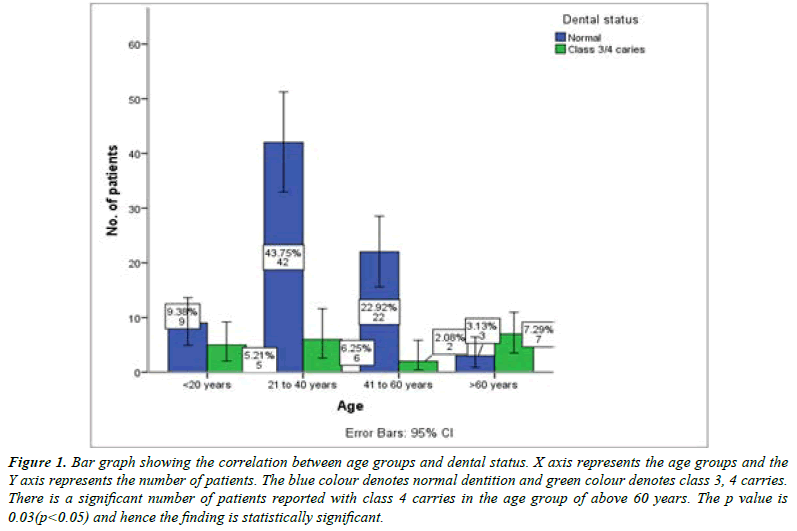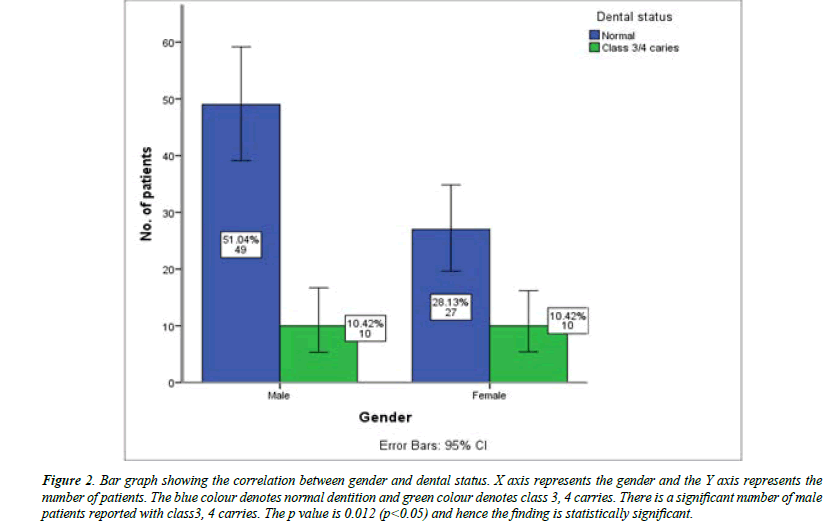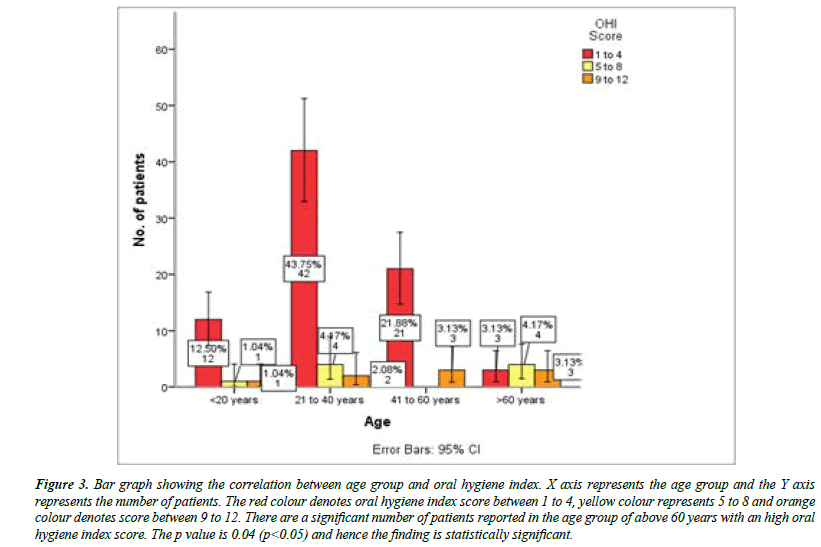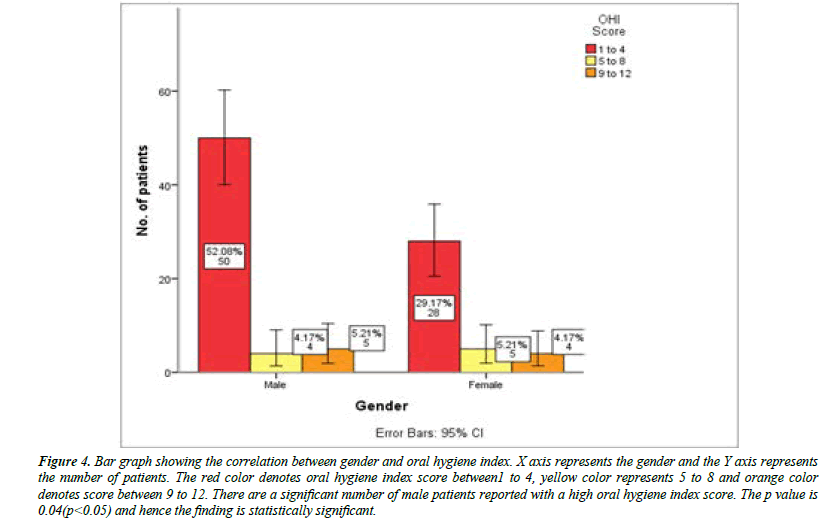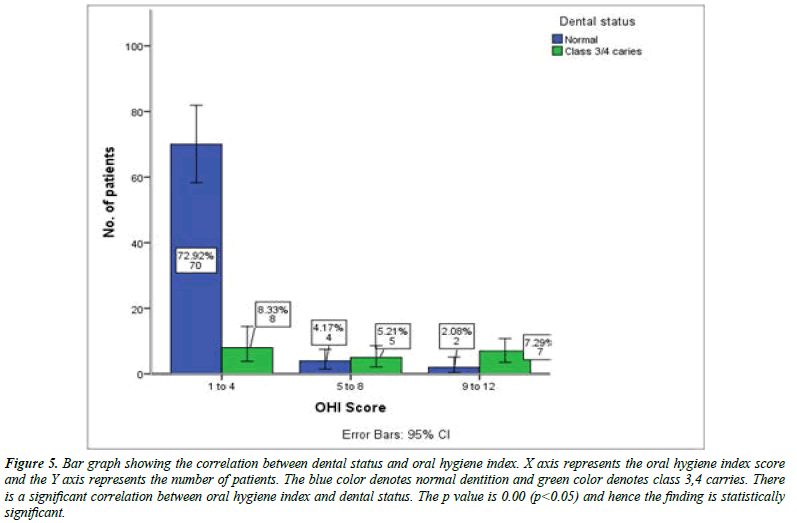Research Article - Journal of Clinical Dentistry and Oral Health (2022) Volume 6, Issue 4
Correlation between oral hygiene index and class 3 or 4 carries
Vaishnavi Devi B and Mahalakshmi J*
Department of Conservative Dentistry and Endodontics, Saveetha Dental College, Saveetha University, Saveetha Institute of Medical and Technical Sciences, Chennai, Tamil Nadu, India
- Corresponding Author:
- Mahalakshmi J
Department of Conservative Dentistry and Endodontics
Saveetha Dental College, Saveetha University
Saveetha Institute of Medical and Technical Sciences
Chennai, Tamil Nadu, India
E-mail: mahalakshmij.sdc@saveetha.com
Received: 27-Jun-2022, Manuscript No. AACDOH-22-67808; Editor assigned: 29-Jun-2022, PreQC No. AACDOH-22-67808(PQ); Reviewed: 14-Jul-2022, QC No.AACDOH-22-67808; Revised: 19-Jul-2022, Manuscript No. AACDOH-22-67808(R); Published: 26-Jul-2022, DOI:10.35841/aacdoh-6.4.116
Citation:Vaishnavi Devi B, Mahalakshmi J. Correlation between oral hygiene index and class 3 or 4 carries. J Clin Dentistry Oral Health. 2022;6(4):116
Abstract
Background: The ability to predict its preference may pave the way towards better coping strategies and help dentists in proper treatment decisions. Aim: The aim of this study is to assess the correlation between OHI and class 3 and 4 carries in patients visiting different outpatient departments of private dental college hospital, Chennai. Materials and method: All the cases referred from the month of September 2020 to February 2021 for class 3 and 4 caries were chosen for the study. Data was collected from the dental hospital record system. Result data was tabulated in excels and imported to SPSS for correlation and association. Chi square statistical test was performed for statistical significance. P<0.05 was considered to be the level of statistical significance in this study. Results: Within the limits of the present study, with an increasing score of oral hygiene index, the prevalence of caries also increases with high male preponderance among the age group of above 60 years. The probability value of the study is p=0.041 and hence the study is statistically significant. Conclusion: It was found that there is a significant correlation between oral hygiene index and class 3, 4 carries. Knowledge about the correlation between OHI and caries will be helpful to the clinician to plan the treatment protocol.
Keywords
Caries, Innovative, Oral health, OHI, Plaque.
Introduction
Dental caries is a multifactorial disease that results in the localised destruction of hard tissues of teeth due to the biofilm formation [1]. It is widely known that dental caries is one of the preventable oral health problems and the most common chronic infectious diseases. It is a preventable disease which occurs mainly due to poor oral hygiene. Caries can occur throughout life, both in primary and permanent dentitions and damages the tooth structure [2]. The balance between pathological and protective factors influences the initiation and progression of caries. Due to lack of knowledge and insufficient preventive measures, there is a high prevalence of morbidity that highly affects the health status of children [3,4]. It is a smoldering disease in developing countries affecting areas where the resources are inadequate for dental treatment, lack of public awareness, and motivation with increased intake of carbohydrates.
Dental caries result from a complex interaction of factors like host susceptibility, bacteria, diet, and time. It is mainly due to ecological imbalance between minerals of the tooth and oral microbial biofilms. The bacteria and sugary food act together to form acids that result in the formation of tooth decay [5]. Consequently, the acid destroys the enamel surface and if not treated at this stage, it might lead to progressive destruction of the tooth. Dental caries have many complications like toothache, pulpitis, tooth loss, discoloration, and space infections [6,7].
Oral health affects an individual both physically and psychologically. Generally, it affects an individual’s physical growth, self-esteem, and social development. The posterior teeth caries usually affect the mastication whereas anterior teeth caries pose a greater burden and negatively affects the aesthetics and quality of life in an individual [8,9]. Oral health also impacts general health, increases risk of pneumonia, complicates diabetes, and rarely oral biofilm can lead to subacute endocarditis. Therefore health-care providers should be familiar with dental caries and its causes. An index is an expression of clinical observation in numeric values. It is used to describe the status of the individual or group with respect to a condition being measured. Oral Hygiene Index (OHI) shows a patient's oral hygiene and expresses the presence of plaque and debris on the surface of the teeth. OHI allows determination of a presence of the dental plaque, materialalba, and food residues. This index is used to determine the oral hygiene maintenance of the patient based on the amount of plaque and calculus present.
Earlier studies have reported the prevalence of caries and its causes; here in our study we have correlated the oral hygiene index scores and class 3, 4 carries. An assessment of correlation of oral hygiene index and class 3 and 4 caries will help us to improve the treatment protocol. Our team has extensive knowledge and research experience that has translated into high quality publications [10-16]. This study will help in raising awareness to dentists by knowing its prevalence in performing endodontic procedures thereby future patient management will be more efficient. The aim of this study is to assess the correlation between oral hygiene index and class 3 and 4 carries.
Materials and Methods
Study setting
The present study was conducted as a retrospective cross sectional study to assess the correlation between oral hygiene index and class 3 or 4 carries in patients visiting the dental hospital. A randomized sample of patients who had reported with class 3 and 4 caries were chosen for the study. The study took place in a private college hospital setting within the university. The retrospective data obtained from the institution was being ethically approved and the number of people involved in the study includes 3 members - Guide, researcher, reviewing expert.
Sampling
All the patient case records were reviewed and analysed for the study. All the cases referred for class 3 and 4 restoration from the month of September 2020 to February 2021 were included for the study. The records of all patient data were reviewed from initial to last and were arranged in chronological order. Sample size n=92 patients. The data collected includes the demographic details, treatment undertaken for the patient. All the treatment report data were properly reviewed and cross verified by another examiner. Sampling bias was minimized by simple random sampling. Internal validity is applicable to the study.
Data analysis
The collected data includes patients' oral hygiene index score and class 3 and 4 restoration reports. Gross incomplete data was excluded as it affects the study. Excel tabulation of all the verified data and importing to the Statistical Package for Social Sciences (SPSS) software, version 1.0.0.1327 64 bit edition (IBM corp., NY, USA) for the statistical tests was done. The data was assessed by being subjected to descriptive analysis with the help of frequencies, percentage and analysed by running descriptive statistics in the form of crosstabs.
Independent variables in the study include ethnicity, age, frequency and gender and the dependent variables include oral hygiene index score, class 3 and 4 restoration. Non parametric test-Chi square statistical test was done and the results were correlated and associated. Statistical significance was set at p<0.05.
Results
The study evaluated the correlation between oral hygiene index and class 3 and 4 patients visiting a private dental institute. A total of treatment records were included in this study. The statistical software SPSS was used for the descriptive and inferential analysis. Results on categorical measurement were presented in percentage (%). Chi square analysis was done for statistical significance. Level of significance was predetermined at the probability value of P=0.05 and any value ≤ 0.05 was considered to be statistically significant.
The association between age group and OHI scores shows that in the age group of less than 20 years, 12% have scores between 1 to 4, 1% has reported scores between 5 to 8 and 9 to 12. In the age group of 21 to 40 years, 43% reported a score between 1 to 4, 4% with score 5 to 8 and 2% between 9 to 12. In the age group of 41 to 60 years, 21% reported a score between 1 to 4. 3% in the score of 9 to 12. In the age group of above 60 years, 4% with scores 5 to 8 and 3% with the rest of the scores. The p value was found to be 0.04 (p<0.05) and hence the finding is statistically significant (Figure 3). The correlation between gender and class 3, 4 caries shows that 52% males and 29% females reported with score 1 to 4. 4% males and 5% reported with a score of 5 to 8. Similarly, 5% males and 4% females reported with the score of 9 to 12. The p value was found to be 0.024 (p<0.05) and hence the finding is statistically significant (Figure 4).
The correlation between oral hygiene index and dental status shows that 72% reported with normal dentition and 8% reported with class 3,4 carries in the score of 1 to 4. 4% reported with normal dentition and 5% with class 3,4 carries in patients reported with scores between 5 to 8. Similarly, 2% reported with normal dentition and 7% reported with class 3, 4 carries in patients reported with scores between 9 to 12. The p value was found to be 0.00(p<0.05) and hence the finding is statistically significant (Figure 5).
Discussion
Dental caries is one of the most common preventable diseases and the people are susceptible to the disease throughout their lifetime [17]. It is the primary cause of tooth pain and tooth loss. It can be arrested and potentially reversed in its early stages, but is often not self-limiting and without proper care, caries can progress until the tooth is destroyed. In low- and middle-income countries, the incidence of dental caries is rapidly increasing [18]. Globally, it has been estimated that 60% to 90% of the adult population have dental caries which means that six to nine adults in every ten are affected by tooth decay [19,20]. G.V. Black has classified the dental caries based on the site and location into six different classifications, where the anterior caries is classified as class 3 and 4 carries. Class 3 caries are the caries present in the anterior teeth without involving the incisal edges and class 4 caries are the ones involving incisal edges.
Any caries involving the anterior tooth surface, can affect the aesthetics of the patient’s smile which might disturb the patient psychologically [21]. Therefore, there is a need to maintain the oral hygiene and treat the caries at its earliest. The caries mainly develop due to the accumulation of plaque and calculus which leads to the biofilm formation [22]. Proper diagnosis of the status of the oral hygiene maintenance can be useful in the diagnosis of caries [23]. Oral hygiene index was developed in the year 1960 by John C. Green and Jack R. Vermillion in order to classify and assess oral hygiene status [24,25]. It is a simple and sensitive method for assessing group or individual oral hygiene quantitatively. It is composed of 2 components: debris and calculus index. The buccal and lingual debris scores are both taken on the tooth in a segment having the greatest surface area covered by debris and calculus. Higher the oral hygiene index score, the poorer the oral hygiene of the patient. Here in our study, we have correlated oral hygiene index score and class 3,4 carries.
The findings of the study shows that the association between age group and dental status shows that patients above 60 years show high prevalence of class 3,4 caries when compared to the other age groups (Figure 1) (p<0.05). Similarly the correlation between age group and OHI scores shows that higher OHI score was noticed in the age group of above 60 years (Figure 2) (p<0.05). The correlation between gender and dental status shows that male patients have reported more with class 3,4 caries when compared to females (Figure 3) (p<0.05). The association between OHI score and gender shows that higher scores were noticed in the male patients (Figure 4) (p<0.05). The correlation between OHI scores and dental status shows that there is a significant correlation. With the increasing score, the number of patients affected also increased (Figure 5) (p<0.05).
Figure 1: Bar graph showing the correlation between age groups and dental status. X axis represents the age groups and the Y axis represents the number of patients. The blue colour denotes normal dentition and green colour denotes class 3, 4 carries. There is a significant number of patients reported with class 4 carries in the age group of above 60 years. The p value is 0.03(p<0.05) and hence the finding is statistically significant. Figure
Figure 2: Bar graph showing the correlation between gender and dental status. X axis represents the gender and the Y axis represents the number of patients. The blue colour denotes normal dentition and green colour denotes class 3, 4 carries. There is a significant number of male patients reported with class3, 4 carries. The p value is 0.012 (p<0.05) and hence the finding is statistically significant.
Figure 3: Bar graph showing the correlation between age group and oral hygiene index. X axis represents the age group and the Y axis represents the number of patients. The red colour denotes oral hygiene index score between 1 to 4, yellow colour represents 5 to 8 and orange colour denotes score between 9 to 12. There are a significant number of patients reported in the age group of above 60 years with an high oral hygiene index score. The p value is 0.04 (p<0.05) and hence the finding is statistically significant.
Figure 4: Bar graph showing the correlation between gender and oral hygiene index. X axis represents the gender and the Y axis represents the number of patients. The red color denotes oral hygiene index score between1 to 4, yellow color represents 5 to 8 and orange color denotes score between 9 to 12. There are a significant number of male patients reported with a high oral hygiene index score. The p value is 0.04(p<;0.05) and hence the finding is statistically significant.
Figure 5: Bar graph showing the correlation between dental status and oral hygiene index. X axis represents the oral hygiene index score and the Y axis represents the number of patients. The blue color denotes normal dentition and green color denotes class 3,4 carries. There is a significant correlation between oral hygiene index and dental status. The p value is 0.00 (p<0.05) and hence the finding is statistically significant.
The findings of this study will assist the clinician to be prepared for the treatment in the patients of that age group and gender by knowing its prevalence. There is a geographic limitation to the study as it predominantly covers the South Indian population and it is also a unicentric study. The sample size was small and follow up of the outcome was not recorded. This can be modified by performing longitudinal and periodic studies to evaluate the correlation and its clinical application. The precision of the oral hygiene index score calculation should also be evaluated. In the future, a larger population with different ethnicity can be included to provide better results and for precise diagnosis. This study gives valuable information to oral health planners in proposing strategies for the development of oral health management.
Conclusion
Within the limits of the present study, with an increasing score of oral hygiene index, the prevalence of caries also increases with high male preponderance among the age group of above 60 years. It was found that there is a significant correlation between oral hygiene index and class 3,4 carries. Knowledge about the correlation between OHI and caries will be helpful to the clinician to plan the treatment protocol.
Acknowledgement
The authors would like to acknowledge the help and support rendered by Saveetha Dental College and Hospitals, Saveetha Institute of Medical and Technical Sciences, Saveetha University, Chennai.
Conflict of interest
The authors declare no potential conflict of interest.
References
- Pitts NB, Zero DT, Marsh PD, et al. Dental caries. Nat Rev Dis Primers. 2017;3(1):1-6.
- Ingle NA, Dubey HV, Kaur N, et al. Prevalence of dental caries among school children of Bharatpur city, India. J Int Soc Prev Community Dent. 2014;4(1):52.
- Sharma V, Gupta N, Arora V, et al. Caries experience in permanent dentition among 11-14 years old school children in Panchkula district (Haryana) India. Int J Sci Study. 2015;3(1):112-115.
- Basha S, Swamy HS. Dental caries experience, tooth surface distribution and associated factors in 6-and 13-year-old school children from Davangere, India. J Clin Exp Dent. 2012;4(4):e210.
- Prasai Dixit L, Shakya A, Shrestha M, et al. Dental caries prevalence, oral health knowledge and practice among indigenous Chepang school children of Nepal. BMC Oral Health. 2013;13(1):1-5.
- Joshi N, Sujan SG, Joshi K, et al. Prevalence, severity and related factors of dental caries in school going children of Vadodara city–an epidemiological study. J Int Oral Health. 2013;5(4):35.
- Mejàre I, Stenlund H, Zelezny-Holmlund C. Caries incidence and lesion progression from adolescence to young adulthood: A prospective 15-year cohort study in Sweden. Caries Res. 2004;38(2):130-41.
- Featherstone JD. The continuum of dental caries—evidence for a dynamic disease process. J Dent Res. 2004;83(1):39-42.
- Hegde MN, Malhotra A, Hegde ND. Prevalence of caries in anterior teeth in adults of Dakshina Kannada Indian population–An epidemiological study. Indian J Dent. 2014;5(1):6-11.
- Vijayashree Priyadharsini J. In silico validation of the non-antibiotic drugs acetaminophen and ibuprofen as antibacterial agents against red complex pathogens. J Periodontol. 2019;90(12):1441–1448.
- Priyadharsini JV, Vijayashree Priyadharsini J, et al. In silico analysis of virulence genes in an emerging dental pathogen A. baumannii and related species. Arch Oral Biol. 2018;94:93–98.
- Uma Maheswari TN, Nivedhitha MS, Ramani P. Expression profile of salivary micro RNA-21 and 31 in oral potentially malignant disorders. Braz Oral Res. 2020;34:e002.
- Gudipaneni RK, Alam MK, Patil SR, et al. Measurement of the maximum occlusal bite force and its relation to the caries spectrum of first permanent molars in early permanent dentition. J Clin Pediatr Dent. 2020;44(46):423–428.
- Chaturvedula BB, Muthukrishnan A, Bhuvaraghan A, et al. Dens invaginatus: A review and orthodontic implications. Br Dent J. 2021;230(6)345–350.
- PradeepKumar AR, Shemesh H, Nivedhitha MS, et al. Diagnosis of vertical root fractures by cone-beam computed tomography in root-filled teeth with confirmation by direct visualization: A systematic review and meta-analysis. J Endod. 2021;47(8):1198–1214.
- Reddy P, Krithikadatta J, Srinivasan V, et al. Dental caries profile and associated risk factors among adolescent school children in an Urban South-Indian city. Oral Health Prev Dent. 2020;18(1):379–386.
- Bader JD, Rozier RG, Lohr KN, et al. Physicians’ roles in preventing dental caries in preschool children: A summary of the evidence for the U.S. preventive services task force. Am J Prev Med. 2004;26(4):315–325.
- Veiga NJ, Aires D, Douglas F, et al. Dental caries: A review. J Dent Oral Health. 2016;2(5):1-3.
- Hooley M, Skouteris H, Boganin C, et al. Parental influence and the development of dental caries in children aged 0–6 years: A systematic review of the literature. J Dent. 2012;40(11):873–885.
- Chesters RK, Pitts NB, Matuliene G, et al. An abbreviated caries clinical trial design validated over 24 months. J Dent Res. 2002;81(9):637–640.
- Liu Y, Lin H, Bai Y, et al. Study on the relationship between Helicobacter pylori in the dental plaque and the occurrence of dental caries or oral hygiene index. Helicobacter. 2008;13: 256–260.
- Zero DT, Fontana M, Martínez-Mier EA, et al. The biology, prevention, diagnosis and treatment of dental caries: scientific advances in the United States. J Am Dent Assoc. 2009;140(1):25S–34S.
- Schwendicke F, Dörfer CE, Schlattmann P, et al. Socioeconomic inequality and caries: A systematic review and meta-analysis. J Dent Res. 2015;94(1):10–18.
- Mergoni G, Percudani D, Lodi G, et al. Prevalence of Candida species in endodontic infections: Systematic review and meta-analysis. J Endodont. 2018;44(11):1616-1625.
- https://www.aryamedipublishing.com/Preventive_Community_Dentistry.htm
Indexing at, Google Scholar, Cross Ref
Indexing at, Google Scholar, Cross Ref
Indexing at, Google Scholar, Cross Ref
Indexing at, Google Scholar, Cross Ref
Indexing at, Google Scholar, Cross Ref
Indexing at, Google Scholar, Cross Ref
Indexing at, Google Scholar, Cross Ref
Indexing at, Google Scholar, Cross Ref
Indexing at, Google Scholar, Cross Ref
Indexing at, Google Scholar, Cross Ref
Indexing at, Google Scholar, Cross Ref
Indexing at, Google Scholar, Cross Ref
Indexing at, Google Scholar, Cross Ref
Indexing at, Google Scholar, Cross Ref
Indexing at, Google Scholar, Cross Ref
Indexing at, Google Scholar, Cross Ref
Indexing at, Google Scholar, Cross Ref
Indexing at, Google Scholar, Cross Ref
Indexing at, Google Scholar, Cross Ref
